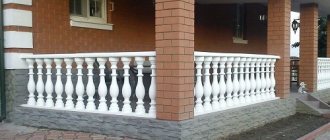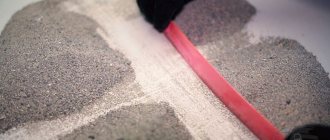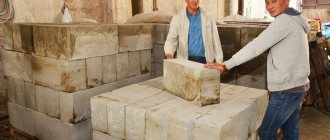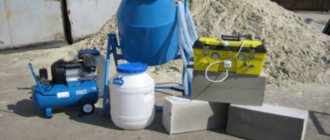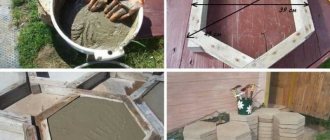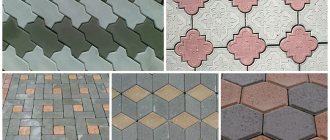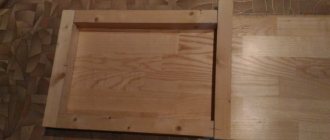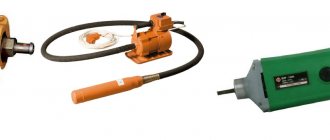Metal mold for foam concrete blocks with horizontal cells.
The main indicator of the accuracy of the geometric dimensions of foam blocks is the quality of the formwork in which they were cast. In the article we will talk about what forms there are for foam blocks, how and from what you can make them with your own hands.
General information about foam block
Before you start creating molds for foam blocks, you should understand what they are. And so, foam concrete consists of sand, cement, foaming agent and water. In addition, to improve certain properties of the material, as well as to increase its strength, it is allowed to add hardeners, plasticizers and fiber.
What is a foaming agent
A foaming agent is an organic or protein-based liquid. This is an environmentally friendly, chemically neutral product. There are two types of foaming agents on the market - protein and synthetic. .
Protein foaming agents have the following properties:
- They have virtually no effect on increasing the setting and hardening time of the foam concrete solution.
- They practically do not degrade the strength of foam concrete.
- They give the foam concrete mass high durability.
- They have weak resistance to all kinds of accelerators, but their addition, as a rule, is not required.
- Using protein foaming agents, it is possible to obtain foam concrete with a density of 300 - 1200 kg/cm3.
Synthetic foaming agents have the following properties:
- Increases the setting and hardening time of the foam concrete solution.
- Significantly reduces the strength of foam concrete.
- Reduces the durability of the foam concrete mass.
- Resistant to various accelerators.
- They do not allow the production of low-density foam concrete.
Properties of foam concrete
The use of a foaming agent gives the material a closed porous structure, i.e. inside the material, the bubbles are isolated from each other. This provides it with high heat-protective and frost-resistant characteristics. In addition, foam concrete does not absorb moisture, unlike many other porous building materials.
Block Dimensions
Recommendations from experts
Experts recommend adhering to some principles and requirements that will allow you to create high-quality material without errors and deviations:
- To make molds for future foam blocks, it is recommended to use plywood with a laminated coating or durable sheets of metal.
- Before placing the solution into the workpiece, it should be treated with the solution, and the structure itself should be covered with plastic film.
- Drying is carried out in a temperature range of 50... 60°C for 48 hours.
- The material can be removed from the mold only after it has completely dried.
- The finished block is kept on pallets for several hours. Only after this is it used for its intended purpose.
- You can start plastering the walls only 3-4 months after laying, since the blocks shrink.
- Before starting finishing work, you should clean the material from dirt and dust, and carefully prepare the surface for applying the layer.
Forms for foam concrete blocks
After manufacturing, foam concrete is in a liquid consistency and spreads over the surface of the equipment, taking into account its viscosity. Not only their size, but also the quality of the finished product depends on the form for the production of foam blocks.
The material and type from which the technological equipment is made primarily depend on the turnover requirements and the scale of production. Turnover depends on the time that passes from pouring to pre-curing.
According to the design features of the form, there are two types - one-piece and detachable. In addition, they may differ in the number of blocks that can be poured at the same time, i.e. single and multi-seat.
Various types of technological equipment make it possible to obtain both finished piece blocks and a solid mass, which, after being removed from the equipment, is cut. Of course, molds for foam blocks are made by hand of the first type, since they allow you to obtain a finished product.
The disadvantage of equipment for the production of piece blocks is that they allow the production of products of a fixed size. Most often, blocks are produced with dimensions of 200*300*600 mm.
The most common materials for making molds are: moisture-resistant plywood, plastic and metal. Not only the technological and operational properties of the equipment, but also its price depend on the type of material.
Plywood forms
- Block forms
Plywood forms
As a rule, such forms are made with a metal frame. Metal structures are necessary in order to give the plywood the necessary rigidity and also prevent its deformation. As a result, this has a positive effect on the quality of products.
The main advantage of plywood equipment is its low cost and ease of manufacture. Operation also does not require large expenses. Molds can withstand at least 40-50 pouring cycles. If you properly maintain and care for plywood equipment, it can last even longer.
A do-it-yourself mold for foam blocks is a knocked-down plywood box with cells. Each cell corresponds to the size of the future product.
Advice! Before pouring the mixture into plywood molds, the inner surface should be lubricated. This will prevent the foam concrete from sticking to the sides and base.
Plastic mold
Plastic molds
Plastic molds for foam blocks are the cheapest. They are easy to use and do not require lubrication before filling. The disadvantage of such forms is their fragility. This is due to their short service life.
Recently, metal frames have begun to be produced into which plastic equipment is installed. They allow you to increase the durability of the forms.
Metal molds
Metal forms
The most durable are metal molds for foam blocks, but they are also the most expensive. However, if we take into account the length of their service life, the cost of the molds is an insignificant part of the cost of finished products.
Making metal equipment is much more difficult. If you do not have this opportunity, then you can look for used foam block molds, which will cost much less than new ones.
Advice! Instead of forms, you can use split formwork.
Cost price
Ready-made store-bought blocks are much more expensive than homemade products. To prepare a cubic meter of quality material corresponding to the D600 brand, you should know what foam and aerated concrete is made from: The standard recipe is as follows:
- 200-250 kg of sand-cement mixture.
- 1.5 l of foam former.
- Water. Can be used from a centralized water supply. The main thing is to correctly calculate the proportions of foam concrete and water.
You should also take into account the cost of electrical energy that will be consumed by the equipment. They may vary depending on the region where the mini-production is located.
Thus, in Moscow, electricity is more expensive than in the Moscow region or remote regions. The bulk of the costs goes to the purchase of cement. At the same time, the volume of financial investments is determined by the type of equipment used.
Foam block production technology
To produce foam blocks, in addition to molds, you will need the following equipment:
- Foam generator.
- Compressor.
- Concrete mixer with a capacity of 80-100 liters.
With this equipment, two workers can produce several cubic meters of foam concrete during a shift.
Assembling metal molds
It makes more sense to make a foam generator yourself, since factory equipment is prohibitively expensive. Foaming components that are sold are reduced tenfold. In addition, when using these components, concrete must be beaten at very high speeds.
The instructions for making a foam generator are quite simple. You can find it on the Internet.
Advice! The quality of the resulting foam can be checked as follows: fill a bucket with it and turn it upside down. High-quality foam should stay in the bucket.
For the production of foam blocks, cement of grade no lower than 400 is used. The presence of impurities in it is not allowed. Please note that sand is not used in the production of thermal insulation blocks with a density of up to 500 kg/m3. When producing concrete with a density of 600 kg/m3 and higher, crushed or natural sand is added to the mixture.
Advice! It is better to use screenings, since their cost is lower and their activity in concrete is higher.
Equipment for the production of foam blocks
To produce 1 m3 of foam concrete on average it is required:
- 310-320 kg of cement.
- 210-220 kg of sand (if foam concrete is produced with a density of 600 kg/m3).
- 100-110 liters of water for the solution and about 55-60 liters for the foaming agent.
- One and a half liters of foam concentrate.
First of all, sand, cement and water are mixed, after which foam is added. The faster the components are mixed, the better the quality of the concrete.
In a regular concrete mixer, mixing foam concrete will take about 20 minutes, since the foam will stay on the surface for a long time. In a barrel with movable blades, the foam will be mixed within a couple of minutes.
The photo shows the structure of foam concrete
After making foam concrete, it is poured either into molds or into collapsible formwork. In the second case, without waiting for complete hardening, the formwork is dismantled and the mass is cut into separate blocks.
The forms should be disassembled no earlier than after 24 hours. Before being sent to the warehouse, products require an additional 16 hours of exposure. The temperature during block production should not drop below +5 degrees Celsius.
Independent production method
When creating foam concrete with your own hands at home, you should calculate the volume of the container where the finished mixture will be placed. Based on the result obtained, you should determine the quantity of all components - for every 0.5 m³, 100 liters of water and 200 kg of cement mixture with sifted sand are used.
First of all, sand and cement are placed in a concrete mixer. Then, using a special device and a foam concentrate, foam is created at a rate of 500 liters of foam per 1 m³. The cement mixture is diluted with water and mixed with foam.
Many foam systems are equipped with a pumping element that allows you to quickly and efficiently pump the mixture into the drum.
After placing the components in the container, they must be thoroughly mixed. To change the density, different amounts of foam are added to the composition. The solution is poured into the mold and dried. Then the dry blocks are taken out and left to dry for 24 hours.
Foam formers are sold in hardware stores or created with your own hands. For this purpose, 150 g of caustic soda, 1 kg of rosin and 60 g of wood glue are used. All substances are combined, heated, and then stirred until smooth. Before production, water is added to the solution.
You can make a mold for the block yourself using available materials. This stage requires increased accuracy and adherence to technology. Otherwise, the geometry of the blocks will be inaccurate. To prevent the solution from leaking out, it should be covered with plastic film. When one portion is removed, you can pour in the next one.
Foam concrete
Foam concrete products are a fairly young generation of environmentally friendly building materials, stepping on the heels of the older generation.
Now, since the 90s, the production and use of foam concrete has increased significantly in volume and is experiencing a real boom.
The material itself was invented and patented relatively recently - in 1924 by the Swedish architect A. Erikson. By historical standards, this is a short period of time.
Foam concrete products are made in the form of blocks, monoliths, using cutting or pouring technologies, using autoclave and non-autoclave methods. In fact, this material can be given any shape.
Material characteristics
To correctly calculate the characteristics of the material, use the table No. 1 given here:
| View | Compressive strength | Foam concrete grade by medium density | Coefficient of thermal conductivity |
| Thermal insulating wall contour | B 0.75 | D400 | 0,09–0,10 |
| B 1 | D500 | 0,10–0,12 | |
| Load-bearing and heat-insulating foam blocks | B 2.5 | D600 | 0,13–0,14 |
| B 3.5 | D700 | 0,15–0,18 | |
| B 5 | D800 | 0,18–0,21 | |
| B 7.5 | D1000 | 0,23–0,29 | |
| Load-bearing walls | B 10 | D1100 | 0,26–0,34 |
| B 12.5 | D1200 | 0,29–0,38 |
The use of foam concrete in the form of blocks or monoliths during the construction of construction projects made it possible to obtain properties that are unattainable when using other materials:
- Firstly, foam concrete is absolutely environmentally friendly; due to its porous structure, it can be conditionally classified as a “breathing” material, which contributes to the formation of a natural microclimate in the building (room).
- Secondly, it is heat (frost resistance) and sound insulation, the latter of which is somewhere around 60 dB. If everything is clear with sound insulation, then there is something to add regarding thermal insulation. Thermal insulation in houses is adjustable due to the same porosity of foam concrete. Mold, mildew or fogging of glass in houses made of foam concrete is an extremely rare occurrence. The air in the pores of the material serves as an additional cushion, preventing the loss of heat or, conversely, coolness, preventing the internal and external temperatures from balancing.
- Thirdly, it is durability and fire safety due to the fire resistance of the material. With fire resistance, everything is also clear - it is achieved by the fact that foam blocks do not contain flammable materials, and therefore do not burn, do not melt, do not crack, and even at high temperatures they hold their shape, do not lose strength and do not collapse. The durability of foam concrete is identical to ordinary concrete, which also only gains strength over time. The durability of the material is associated with high weather resistance and is explained by the material’s low moisture absorption.
- Fourthly, it is ergonomics and efficiency. Products made of foam concrete, subject to compliance with the requirements of state standards (GOST 12.1.007–76, GOST 25485–89 “Cellular concrete. Technical conditions”), according to the degree of exposure to harmful substances on the body (according to toxicological characteristics), belong to the non-hazardous category - low-hazard substances. In fact, this is a degree close to absolute environmental friendliness, which cannot be improved even if the porous surface of the blocks is filled with environmentally friendly air from alpine meadows. Ergonomics and efficiency are determined by the low cost of the material or products made from it, size, and weight. So, with an average block size (60cm x 30cm x 20cm), almost thirteen times the size of a regular brick (25cm x 12cm x 8.8cm), its weight is only a little more than 23 kg. When the ratio of the volume of foam concrete to brick or wood (1 m³) is 1/1, foam concrete is cheaper than wood on average by 30%, and brick by 40. Reducing weight with increased volume and permissible strength reduces the weight of the entire building and reduces the pressure on the foundation.
- And finally, fifthly, it is ease of processing. This material is perfectly sawn, processed, and practically does not chip. No special or expensive equipment is required for processing. A regular hacksaw will do just fine.

